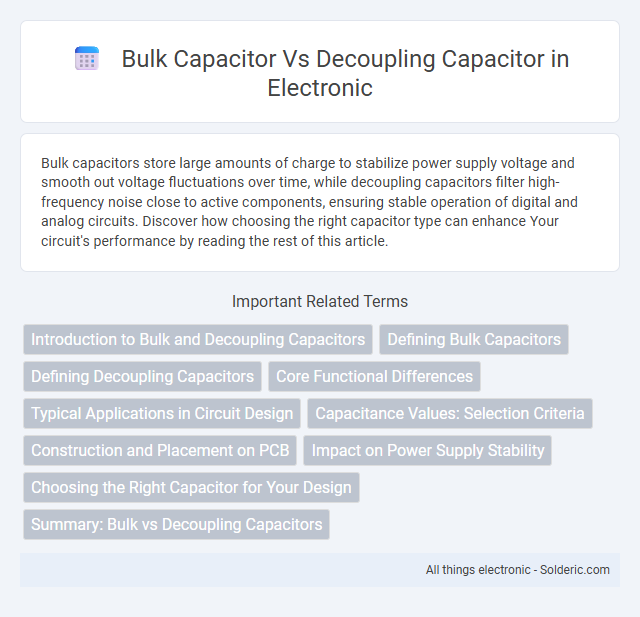Bulk capacitors store large amounts of charge to stabilize power supply voltage and smooth out voltage fluctuations over time, while decoupling capacitors filter high-frequency noise close to active components, ensuring stable operation of digital and analog circuits. Discover how choosing the right capacitor type can enhance Your circuit's performance by reading the rest of this article.
Comparison Table
| Feature | Bulk Capacitor | Decoupling Capacitor |
|---|---|---|
| Purpose | Provides energy storage and manages overall power supply stability | Filters high-frequency noise close to IC power pins |
| Capacitance Value | Typically high (10uF to 1000uF) | Low to medium (0.01uF to 1uF) |
| Placement | Near power supply input or bulk power rails | Placed very close to active device pins |
| Frequency Response | Effective at low frequencies | Targets high-frequency transient noise |
| Role in Circuit | Stabilizes voltage levels under load changes | Reduces voltage spikes and electromagnetic interference (EMI) |
| Typical Materials | Electrolytic, tantalum | Ceramic, multilayer ceramic capacitors (MLCC) |
| Cost | Generally higher due to larger size and capacitance | Lower cost per unit, used in greater quantity |
Introduction to Bulk and Decoupling Capacitors
Bulk capacitors provide large capacitance values essential for stabilizing power supply voltage by storing and releasing energy during high current demands, whereas decoupling capacitors are small-value capacitors placed close to ICs to filter high-frequency noise and ensure signal integrity. Bulk capacitors are typically electrolytic or tantalum types suited for low-frequency transient response, while decoupling capacitors, often ceramic, address high-frequency noise suppression. Understanding the distinct roles and placement of these capacitors is crucial for optimizing power delivery and minimizing electromagnetic interference in electronic circuits.
Defining Bulk Capacitors
Bulk capacitors store large amounts of charge to stabilize voltage supply in electronic circuits by smoothing out low-frequency variations and sudden power demands. They are typically electrolytic capacitors with high capacitance values, designed to provide energy buffering and reduce voltage ripple in power supply lines. Understanding your circuit's power requirements can help determine the appropriate bulk capacitor needed for optimal performance and reliability.
Defining Decoupling Capacitors
Decoupling capacitors stabilize power supply voltage by filtering out high-frequency noise near integrated circuits, ensuring reliable operation of your electronic components. Unlike bulk capacitors, which handle large energy storage and smooth low-frequency fluctuations, decoupling capacitors are small-value components placed close to IC power pins for rapid response to transient current demands. These capacitors are essential in preventing voltage dips and electromagnetic interference in high-speed digital circuits.
Core Functional Differences
Bulk capacitors primarily store and supply large amounts of energy to stabilize power distribution over longer time frames, preventing voltage drops during high current demands. Decoupling capacitors act as local energy reservoirs that filter high-frequency noise and provide immediate transient current to integrated circuits, improving signal integrity. Your circuit design benefits from combining bulk capacitors for overall power stability and decoupling capacitors for noise reduction and voltage regulation.
Typical Applications in Circuit Design
Bulk capacitors are primarily used in power supply circuits to stabilize voltage and provide energy storage for high-current demands, often found in DC-DC converters and power distribution networks. Decoupling capacitors are placed near integrated circuits and microcontrollers to filter out high-frequency noise and smooth transient voltage spikes, improving signal integrity in digital and analog circuits. Both capacitors work in tandem to maintain stable power delivery and minimize electromagnetic interference in complex electronic systems.
Capacitance Values: Selection Criteria
Bulk capacitors typically have high capacitance values, ranging from microfarads to millifarads, chosen to stabilize power supply voltage and smooth out low-frequency noise. Decoupling capacitors feature lower capacitance values, generally in the picofarad to nanofarad range, selected to filter high-frequency noise and provide rapid transient current near integrated circuits. Selection criteria depend on the frequency spectrum of the noise and the required response time, with bulk capacitors preferred for bulk energy storage and decoupling capacitors for high-frequency noise suppression.
Construction and Placement on PCB
Bulk capacitors typically have larger capacitance values and are constructed using electrolytic or tantalum materials, designed for energy storage and smoothing voltage fluctuations. They are usually placed near the power supply input or voltage regulator on the PCB to stabilize the main power rail. Decoupling capacitors, often ceramic and much smaller in capacitance, are placed close to individual integrated circuit pins to filter high-frequency noise and ensure local voltage stability.
Impact on Power Supply Stability
Bulk capacitors improve power supply stability by providing large energy reserves to smooth out low-frequency voltage fluctuations and sudden load changes. Decoupling capacitors enhance stability at high frequencies by filtering out noise and transient spikes near integrated circuits. Effective power supply design combines both capacitor types to maintain stable voltage levels across varying operational conditions.
Choosing the Right Capacitor for Your Design
Choosing the right capacitor for your design depends on the specific function it needs to serve: bulk capacitors, typically electrolytic or tantalum, provide high capacitance values to stabilize power supply voltage by smoothing out low-frequency fluctuations and supplying large transient currents. Decoupling capacitors, usually ceramic with low equivalent series resistance (ESR), are positioned close to integrated circuits to filter high-frequency noise and maintain signal integrity by reducing voltage spikes. Optimizing your circuit's performance requires balancing bulk capacitors' energy storage capabilities with decoupling capacitors' noise suppression to ensure stable power delivery and minimize electromagnetic interference.
Summary: Bulk vs Decoupling Capacitors
Bulk capacitors store large amounts of charge to stabilize power supply lines and handle high transient currents in electronic circuits. Decoupling capacitors filter high-frequency noise and provide localized energy near integrated circuits to maintain signal integrity. Together, these capacitors complement each other by ensuring stable voltage levels and minimizing electromagnetic interference.
Bulk capacitor vs decoupling capacitor Infographic

 solderic.com
solderic.com